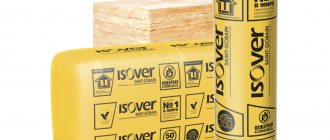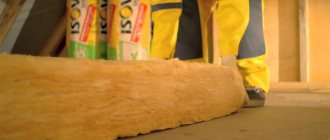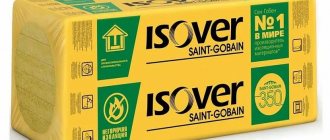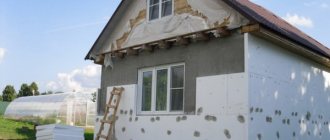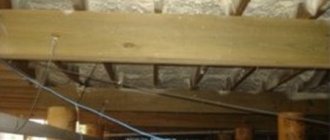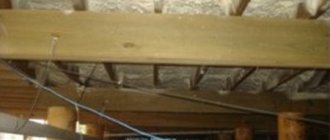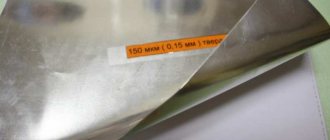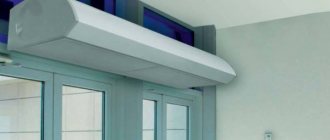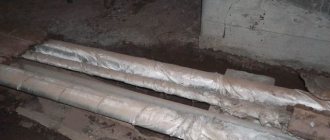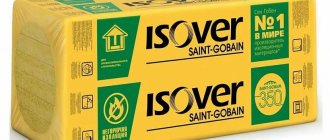The name of the material Izover Optimal series speaks for itself. Basalt wool is truly one of the best options for solving problems related to the thermal insulation of buildings, structures and construction elements.
Non-flammability, environmental friendliness, ease of installation and relative low cost - these are precisely the advantages that encourage buyers to choose this series of materials. They are easily used for thermal insulation of wooden buildings and any structures of various configurations.
Vapor permeability coefficient
The characteristics of insulating boards inspire confidence in buyers and are not inferior to expensive analogues that are presented on the building materials markets. They are distinguished by a thermal conductivity coefficient ranging from 0.036 W/(m*K) to 0.042 W/(m*K).
Izover Optimal insulation is often used in house construction and even in wooden houses, as it belongs to the class of non-combustible materials. The main advantage is ease of installation, which does not require additional fastening. The mats can be stapled or inserted into special slats.
The vapor permeability of the mats is at least 0.30 mg/m*Pa. This indicates resistance to water penetration, which guarantees protection against mold and mildew, which often affects similar products from the cheap segment of the market.
The scope of application of Isover Optimal in private homes is quite extensive:
- for pitched roofs and attic floors;
- for floors along installed joists;
- in the construction of suspended ceilings;
- for interfloor ceilings;
- for frame walls;
- for interior partitions.
In addition, it is extremely difficult to find insulation warmer than Izover Optimal in a similar segment in the building materials markets. In addition to excellent thermal conductivity, it has good sound insulation.
What is Izover insulation?
This insulation is represented by mineral wool - a fibrous material that is manufactured in the form of slabs, rolls and mats. The thickness of the glass fibers is 4-5 microns, and the length is 100-150 microns. Only natural ingredients are used for production, so there is no need to worry about the environmental friendliness of the material.
Plates can be rigid or semi-rigid. The insulation is installed both horizontally and vertically, both during interior work and when arranging facades.
Izover
It is made from sand (quartz) and broken glass. To improve certain properties, soda, borax, limestone and other components can be added to the material. The entire mass is poured into a special bunker. There the process of melting the ingredients takes place. When the molten glass leaves the centrifuge, it forms filaments due to the steam blowing. When they hit the rollers, the aerosol-impregnated threads are leveled and form a carpet. Then at +250°C the polymerization process occurs. When the material cools, it is cut into rolls, mats and slabs.
Tensile strength
The tensile strength of Isover slabs of the Optimal series when stretched parallel to the surfaces is 6 kPa. This indicator makes it possible to use them on large surfaces without the risk of deformation.
When choosing a method for insulating your home, we recommend paying attention to this series. Improved performance and excellent technical characteristics will allow you to use the insulation for many years. At the same time, it will retain its properties throughout its entire service life.
Technical characteristics, advantages and disadvantages
*
Since insulation is the main role of Izover, it is worth paying attention to its thermal conductivity. The thermal conductivity coefficient is within 0.038 W/(m*K). Other advantages include the following factors:
- Good sound insulation. Using mineral wool in interior partitions you can achieve a good effect.
- It is not eaten by rodents and insects. Therefore, using such material for the facade, you don’t have to be afraid that holes from rodents will appear in it later.
- Easy to install. This material comes in various forms, so you can choose the one that will be optimal for the job at hand.
- Long service life - 50 years.
- The material does not deform under compression and has tensile strength. Thanks to its good compressibility, it is convenient to transport.
- Resistance to extreme temperatures.
- The insulation is not flammable, therefore it meets high fire safety requirements.
Ceiling insulation
Disadvantages of the material:
- The need to use protective equipment during installation work. Although over time there will be no harm from mineral wool, when installing thermal insulation it is necessary to protect the respiratory system.
- High moisture permeability. If it gets wet during operation or during installation, the heat-shielding properties will be lost. Therefore, when doing facade work, the mineral wool needs to be either covered or covered with a layer of plaster as soon as possible after installation. This will prevent the harmful effects of precipitation.
Safety precautions when working with mineral wool
Types of Izover
*
Due to the wide variety of forms, Izover mineral wool is used in a variety of fields. When building a house, it can be used to insulate ventilated facades, attics, floors, ceilings and internal partitions. Each model has its own purpose and is used in a specific area, so it is difficult to give a general description of the material. However, each type can be considered separately.
Isover Optimal
Its density is 28-37 kg/m3. It is available in the form of slabs. It is used for a frame house. They can insulate roofs, floors, and walls. It is used as sound insulation for interior partitions and ceilings between floors. Slab dimensions - 60*100 cm, thickness - 5 cm or 10 cm. One package contains 4 slabs (10 cm) or 8 slabs (5 cm).
Isover Roof V Optimal is available in a smaller thickness - 3 or 5 cm. In most cases, it is used for flat roofs. Despite the small thickness of the material, its structure is homogeneous. It can withstand a load of 7 tons per 1 m2.
Isover Standard
This model is used for thermal insulation of facade walls before covering with siding or facing bricks. They also sheathe frame structures. They are produced in the same sizes as the Optimal series mineral wool. Among its characteristics, it should be noted low compressibility under a specific load of 2 kPa - 10%. The density of Izover Standard slabs is 50 kg/m3.
Isover Venti
This product is intended for insulation of ventilated facades, and there is no restriction on the height of the building. This is achieved by the fact that this material has high mechanical strength. It is also produced in slabs measuring 60-100 cm with a thickness of 5 or 10 cm. The density of the material is 85 kg/m3. Thanks to high vapor permeability, moisture is effectively removed from the structure. Like other mineral wool materials, Izover Venti does not burn.
Izover for ventilated facades
The Isover Venti Optimal model range has slabs with thicknesses from 3 to 20 cm. This allows you to choose the most suitable solution for each insulated facade.
Izover Facade
*
This model range is used for insulation of plaster facades. If pebble plaster is chosen as the finishing material and the insulation will need to be covered with a thin layer of plaster, then this option must be chosen. The thickness of the produced slabs varies from 5 to 20 cm, width - 60 cm, length - 100 cm.
Density characteristics of Izover Plaster Facade - 145 kg/m3. For simplified and accelerated installation of such slabs on the wall surface, this material is available in other geometric dimensions - 60*120 cm.
Isover for plaster facades
Isover Light
It is used in various fields - interior partitions, suspended ceilings, ventilated facades and frame structures. Isover Light has increased elastic properties of the plate. Material density - 38 kg/m³. During operation, it does not shrink or deform.
Isover Classic
It is used for thermal insulation of floors and ceilings and is laid between joists. Izover Classic is produced in rolls, and during transportation, mineral wool is compressed 6 times. Density - 11 kg/m3. The width of the roll is 122 cm, the material in it is folded into two layers of 5 cm thick, so during installation it is easy to select the desired thickness of insulation. Since the width between the joists can be 60 cm, the mats are cut lengthwise into two parts 61 cm wide and laid tightly between the boards.
Thermal insulation of floors
*
Isover Sauna
This model also has a vapor barrier. The presence of a foil layer makes it possible to preserve the high temperature of the sauna for a long time. This will also save time on installation work, since two stages are performed at once and there is no need to install additional films or membranes. The thickness of Izover Sauna is 50 or 100 mm. It is used to insulate not only walls, but also ceilings in bathhouses.
Izover Master of Acoustics
It is used where it is necessary to create acoustic insulation. It is produced in the form of mineral wool slabs based on stone fiber. It is used for external walls, interior partitions, floors and ceilings, that is, wherever high-quality sound insulation by Izover Master may be needed.
Isover Flor
This insulation is used to protect against impact noise. It reduces noise levels by 35 dB. Isover Floor is produced by the manufacturer in the form of rigid slabs measuring 60*120 cm and 3-5 cm thick.
Izover Profi
This is the warmest material among its analogues. It is produced in rolls and is used in many inclined structures, for example, when insulating roofs, plasterboard partitions on a metal frame. Izover Profi is also used before finishing the facade with siding or facing bricks. The thickness of the rolls is 5, 10 or 15 cm. The length of the roll is 4-5 meters.
There are other varieties of this insulation. Thanks to this variety, you can choose the most suitable material for high-quality thermal insulation work. You can also choose the thickness and dimensions of the insulation. By carrying out all the work correctly, you can significantly save heating costs and ensure comfortable indoor conditions.
Existing varieties and scope of application
The French concern Saint-Gobain produces various types of insulation materials. Nine types of isover are most popular on the Russian market:
- Thermal insulation isover KL 34 - unpressed slabs that have a very wide range of applications, used for insulation of any vertical and horizontal surfaces . A wooden sheathing is constructed for installation . The plates are inserted inside it without additional fastening.
- Isover KL 37 – pressed boards packed in packaging . They are used for insulating floors between two adjacent floors , internal walls and roof slopes .
Important! When installing the plates, they must be pressed tightly against each other.
Scope of use of different types of isover Source www.tproekt.com
- Isover KT 37 – roll thermal insulation. Used for insulating horizontal surfaces. Izover of this form can also be installed on walls, but only if it is necessary to insulate internal partitions .
- Isover KT 40 – two-layer rolls used for ceiling and floor .
- Isover "STYROFOAM" 300 A expanded polystyrene has been added to its structure . These are plates of increased rigidity . They are attached to the surface using plastic dowels or special adhesives based on bitumen mastics.
- Isover “VENTITERM” – slabs additionally treated with a water repellent . This is a new product, it is just conquering the market. Its scope of application is insulation of facades , carried out by installing single-layer or two-layer systems.
- Isover insulation “pitched roof” is a material designed for roof insulation to improve the sound insulation of a room. Produced in the form of slabs with dimensions 610x11700 mm, thickness 10 cm. The material has high elasticity and elasticity, therefore
Insulation plus sound insulation Source e-teplo.kz

